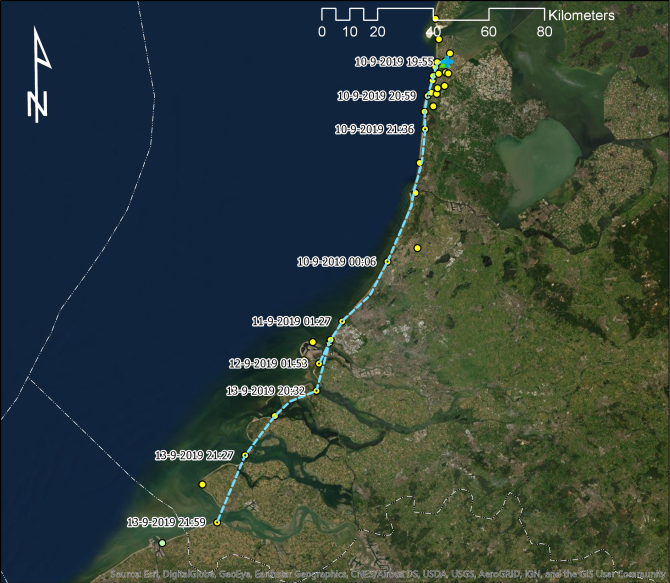
Project
Telemetry research Nathusius' pipistrelle
Migrating species such as Nathusius' pipistrelle pass wind turbines during their migration from summer to winter areas and vice versa. An advanced telemetry network allows bats to be tracked along their route, giving us insight into their migration patterns as well as their behaviour in wind farms.
Research on land shows that bats frequently become victim of wind turbines. In Europe, most of the fatalities occur among migrating species such as Nathusius’ pipistrelle, Common noctule and Particoloured bat. It is likely that fatalities also occur at sea. It is currently unclear what consequences wind farms in the North Sea could have on the population level. Therefore Wageningen Marine Research is conducting research in the context of the Offshore Wind Ecological Program (Wozep) of the Directorate-General for Public Works and Water Management (Rijkswaterstaat), commissioned by the Ministry of Economic Affairs and Climate (EZK), into the possible effects on Nathusius' pipistrelle in particular.
Telemetry
One of the projects within the Wozep programme is telemetry research into the migration behaviour of Nathusius' pipistrelle. With this research, we attempt to answer the following questions:
- Which part of the population migrates along the coast and which part over sea?
- Are bats attracted to offshore wind farms and, if so, from what distance?
- How long do bats stay in offshore wind farms?
The telemetry study uses the MOTUS Wildlife Tracking System. Since 2017, we have been working on the realisation of a network of receiving stations along the Dutch coast. In addition, we have deployed a number of receiving stations in the United Kingdom. Together with the receiving stations deployed by other organisations, the Motus network in Europe now includes 116 locations, 90 of which are around the southern North Sea.
Tagging

In the period of 2018-2020, we have tagged a total of 330 Nathusius' pipistrelle at various locations along the Dutch coast. The tag is affixed with surgical skin glue and will fall off after a few weeks.
Due to the tags, we know exactly which bat flies past which telemetry station, and on this basis we can reconstruct the route travelled. The preliminary results show that the animals migrate both by sea and along the coast. Below is an example of one of the registered flight paths.

This adult female that was tagged and released near Julianadorp on September 10, 2019. The animal left the same evening just after sunset. She was tracked by nine different receiver stations in North Holland. Later that night the animal flew past Noordwijk, The Hague and then arrived in Hoek van Holland. She stayed there for two nights, making a short trip to Oostvoorne. The following night the animal flew via the Haringvlietdam, Brouwersdam and Oosterscheldekering to Breskens.
In the autumn of 2021, we will again tag approximately 150 Nathusius' pipistrelle in the Netherlands. In addition, we will tag in the UK in spring for the first time. This will give us insight into the spring migration ecology.
